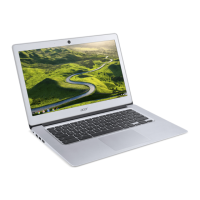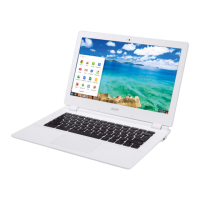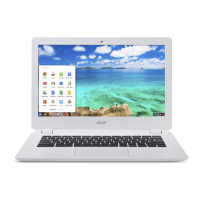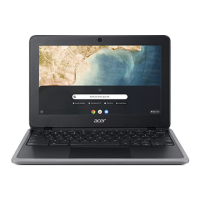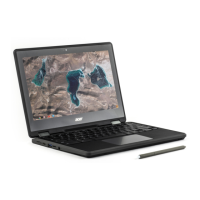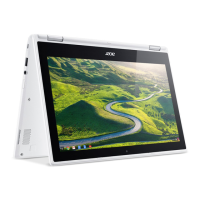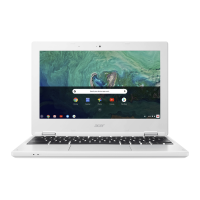
 Loading...
Loading...
Do you have a question about the Acer Chromebook 11 and is the answer not in the manual?
| Start-up time | 8 s |
|---|---|
| Form factor | Clamshell |
| Product type | Chromebook |
| Product color | White |
| Market positioning | Business |
| Numeric keypad | No |
| Pointing device | Touchpad |
| Operating system installed | ChromeOS |
| Stepping | C0 |
| Tjunction | 100 °C |
| Processor cache | 1 MB |
| Processor cores | 2 |
| System bus rate | - GT/s |
| Processor family | Intel® Celeron® |
| Processor series | Intel Celeron Processor N2000 Series for Mobile |
| Processor socket | BGA 1170 |
| Processor codename | Bay Trail |
| Processor frequency | 2.16 GHz |
| Processor cache type | L2 |
| Processor lithography | 22 nm |
| Processor manufacturer | Intel |
| Processor front side bus | - MHz |
| PCI Express slots version | 2.0 |
| Processor boost frequency | 2.58 GHz |
| Processor operating modes | 32-bit, 64-bit |
| PCI Express configurations | 1x4 |
| Thermal Design Power (TDP) | 7.5 W |
| Scenario Design Power (SDP) | 4.5 W |
| Maximum number of PCI Express lanes | 4 |
| Internal memory | 2 GB |
| Memory clock speed | 1333 MHz |
| Internal memory type | DDR3L-SDRAM |
| Maximum internal memory | - GB |
| Storage media | Flash |
| Card reader integrated | Yes |
| Total storage capacity | 16 GB |
| Compatible memory cards | SD |
| Display diagonal | 11.6 \ |
| Display resolution | 1366 x 768 pixels |
| Native aspect ratio | 16:9 |
| Discrete graphics card model | Not available |
| On-board graphics card model | Intel® HD Graphics |
| On-board graphics card base frequency | 311 MHz |
| On-board graphics card burst frequency | 792 MHz |
| Number of battery cells | 3 |
| AC adapter power | 45 W |
| AC adapter frequency | 50 - 60 Hz |
| AC adapter input voltage | 100 - 240 V |
| Audio system | HD |
| Wi-Fi standards | 802.11a, Wi-Fi 5 (802.11ac), 802.11b, 802.11g, Wi-Fi 4 (802.11n) |
| Bluetooth version | 4.0 |
| Top Wi-Fi standard | Wi-Fi 5 (802.11ac) |
| Intel segment tagging | Education |
| Charging port type | DC-in jack |
| USB 2.0 ports quantity | 1 |
| VGA (D-Sub) ports quantity | 0 |
| Processor code | SR1YJ |
| Processor ARK ID | 82103 |
| Processor package size | 25 x 27 mm |
| Intel Smart Connect Technology version | 1.00 |
| Depth | 204 mm |
|---|---|
| Width | 294 mm |
| Height | 18.6 mm |
| Weight | 1100 g |
Steps to register your Acer product online via the website.
Information on purchasing warranty extensions and accessories online.
Instructions on powering on the Acer Chromebook device.
Guide to choosing the default language for the Chromebook.
Steps for connecting the Chromebook to a wireless network.
Process of accepting service terms and downloading system updates.
Instructions for logging into an existing Google Account.
Guide to setting up a new Google Account for services.
Option to use the Chromebook without a Google Account.
How to choose or take a picture for your user account profile.
Identification of components on the front of the Chromebook.
Details of keyboard layout, touchpad, and power indicators.
Explanation of dedicated function keys and their uses.
Guide to touchpad gestures for clicking, scrolling, and dragging.
Identification of ports on the left side of the Chromebook.
Identification of ports on the right side of the Chromebook.
Identification of ports on the rear of the Chromebook.
Identification of speakers on the bottom of the Chromebook.
Operating temperature and humidity guidelines for the device.
Introduction to the Chrome OS desktop interface and elements.
Explanation of icons used for window management.
Description of the launcher for accessing applications.
Overview of the status area and access to settings.
List of common applications accessible via the launcher.
Explanation of icons and functions in the status area.
Instructions for installing, removing, and customizing apps.
Overview of saving files to Google Drive and local storage.
Step-by-step guide to uploading files from Downloads to Google Drive.
How to make Google Drive files accessible without an internet connection.
Instructions for composing and sending emails using Gmail.
Guide to creating new documents in Google Docs.
How to access YouTube for videos via the launcher.
Information on supported media file types and playback.
List of other file formats supported by the Chromebook.
Guide to installing new applications from the Chrome Web Store.
Steps for creating new documents using Google Docs.
Instructions for sharing documents and inviting collaborators.
Guide to initiating video calls using Google Hangouts.
Steps to play music using Google Play Music and other apps.
Guide to accessing video content via YouTube and other apps.
Instructions for opening and converting Microsoft Office files.
Guide to using Gmail and other apps offline.
Enabling offline access for Google Docs, Sheets, and Slides.
How to access advanced settings within the Chromebook.
Steps to modify language preferences and keyboard input.
Guide to adjusting the time format and time zone.
Instructions for changing the wallpaper and theme.
Steps to select and apply a new wallpaper.
Guide to choosing and applying themes from the Chrome Web Store.
Information on using Google Cloud Print for printer setup.
Instructions for automatic and manual Chrome OS updates.
Accessing help resources for troubleshooting and system information.
General safety guidelines for using the product.
Procedure for safely powering off the device for cleaning.
Precautions for connecting and disconnecting the power supply unit.
Guidance on accessible power outlet placement for safety.
Information regarding dummy cards in card slots.
Important warnings regarding product placement, ventilation, and object insertion.
Guidelines for safe operation with electrical power sources.
Instructions on when to seek qualified service personnel for the product.
Precautions for using and charging the Lithium-ion battery.
Instructions and warnings for replacing the notebook battery.
Warning about turning off wireless devices in certain conditions.
Information on potential interference with medical devices like pacemakers.
Precautions regarding RF signals and electronic systems in vehicles.
Safety guidelines for operating devices in potentially explosive areas.
Disclaimer regarding the inability to make emergency calls.
Information on proper electronic waste disposal and recycling.
General advice for comfortable computer usage and ergonomics.
Tips for adjusting posture, seating, and monitor position for comfort.
Suggestions for reducing eyestrain during computer use.
Work habits that promote relaxation and productivity during computer use.
Compliance information regarding FCC rules for digital devices.
Requirement for using shielded cables for computing device connections.
Guidelines for attaching certified peripheral devices to the equipment.
Warning about modifications voiding user authority.
FCC operational conditions and Canadian user notices.
Compliance statement for Canadian digital apparatus.
Acer's declaration of compliance with EU directives.
Explanation of potential LCD pixel variations and their meaning.
General compliance with radio frequency and safety standards.
Details on R&TTE Directive conformity and applicable harmonized standards.
FCC requirements for wireless LAN and Bluetooth regarding RF exposure.
Compliance with Canadian RF exposure guidelines and regulations.
